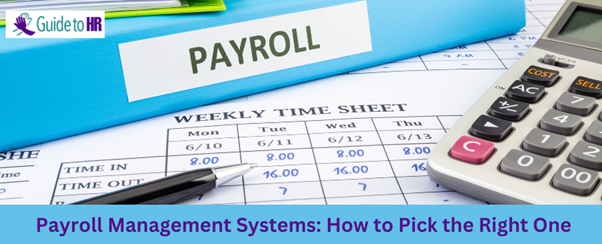In today’s fast-paced business environment, managing payroll efficiently and accurately is crucial for employee satisfaction, legal compliance, and overall business success. Manual payroll processing can be time-consuming, prone to errors, and inefficient, especially as your company grows. Implementing a payroll management system (PMS) can revolutionize your payroll process, saving time and resources and ensuring accuracy. However, choosing the right PMS amidst a multitude of options can be overwhelming. This comprehensive guide empowers you to navigate the selection process effectively and find the ideal payroll solution for your specific needs.
Understanding Payroll Management Systems:
A payroll management system is a software application designed to automate and streamline various aspects of the payroll process, including:
- Employee data management: Securely store and manage employee information, including names, addresses, tax information, and pay rates.
- Time and attendance tracking: Integrate with time clocks or other tracking software to capture accurate employee work hours.
- Payroll calculations: Automatically calculate salaries, wages, taxes, deductions, and withholdings based on various factors.
- Paycheck generation and distribution: Generate and distribute paychecks electronically or through direct deposit.
- Tax filing and reporting: calculate, file, and submit payroll taxes to relevant government agencies.
- Reporting and analytics: Generate reports for payroll audits, tax purposes, and data-driven insights into workforce costs.
Benefits of a Payroll Management System:
Implementing a PMS offers numerous advantages for your business, including:
- Increased Efficiency: Automating routine tasks like calculations, data entry, and reporting saves time and resources compared to manual processes.
- Improved Accuracy: Automated calculations minimize the risk of human error, ensuring accurate payroll processing and avoiding costly mistakes.
- Enhanced Compliance: PMS facilitates timely and accurate tax filing and reporting, minimizing the risk of penalties and non-compliance issues.
- Reduced Administrative Burden: Streamlined processes free up HR staff time, allowing them to focus on more strategic initiatives.
- Increased Security: PMS offers robust data security features to protect sensitive employee information and ensure data privacy.
- Improved Employee Self-Service: Some systems allow employees to access pay stubs, W-2s, and other information online, fostering transparency and convenience.
Choosing the Right Payroll Management System:
Selecting the right PMS requires careful consideration of several factors:
1. Define your needs & budget:
- Analyze your current payroll process: Identify your specific needs and challenges. How many employees do you have? Are there any complexities, like multiple pay types or overtime calculations?
- Determine your budget: Set a realistic budget for the PMS, considering one-time implementation costs, subscription fees, and potential training expenses.
2. Research and compare features:
- Research different PMS options: Compare features, functionalities, and pricing structures offered by various providers.
- Consider essential features: Look for a system offering core functionalities like time and attendance tracking, payroll calculations, and tax filing.
- Evaluate additional features: Explore advanced features like employee self-service options, reporting and analytics tools, and integration capabilities with your existing HR or accounting software.
3. Ease of Use and Scalability:
- Choose a user-friendly system: Ensure the interface is easy to navigate for your HR staff and, if applicable, employees accessing self-service features.
- Consider scalability: Choose a system that can grow with your business, accommodating potential increases in employee size and complexity of payroll needs.
4. Security and Customer Support:
- Prioritize data security: Ensure the PMS offers robust security features to safeguard sensitive employee information, complying with relevant data privacy regulations.
- Evaluate customer support: Choose a provider offering reliable customer support to address any issues or answer questions promptly.
5. Free Trials and Demos:
- Take advantage of free trials or demos: Many providers offer free trials or demos to gain hands-on experience with the system before making a final decision.
- Ask questions and seek references: Don’t hesitate to ask the provider detailed questions and request references from satisfied clients to gain insights into their experience.
Additional Considerations:
- Integration with existing software: Choose a PMS that integrates seamlessly with your existing HR or accounting software, avoiding data silos and streamlining workflows.
- Compliance with regulations: Ensure the PMS complies with relevant tax regulations and labor laws in your region.
Conclusion:
Choosing the right payroll management system is a crucial decision that impacts your business efficiency, employee satisfaction, and overall financial health. By carefully defining your needs, conducting thorough research, and considering the factors mentioned above, you can find the perfect PMS that empowers you to streamline your payroll processes, minimize risks, and ensure accurate and timely payments for your employees. Remember, a well-chosen PMS can be a valuable asset, freeing up valuable resources, allowing you to focus on core business activities, and fostering a thriving workforce.
FAQs:
Q: Who can benefit from a payroll management system?
A: Payroll management systems are beneficial for businesses of all sizes, from small startups to large corporations. They can save time, reduce errors, and improve efficiency for any organization managing payroll processes.
Q: How much does a payroll management system cost?
A: Costs can vary depending on several factors, including the number of employees, chosen features, and
the provider’s pricing model (subscription fees, per-employee fees, etc.).
Q: Is it easy to switch to a new payroll management system?
A: Transitioning to a new PMS requires careful planning and execution. Choose a provider that offers support during the implementation process, including data migration assistance and training for your staff.


